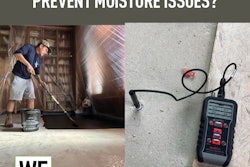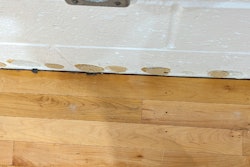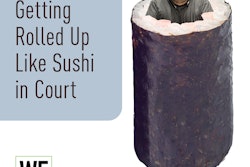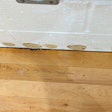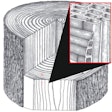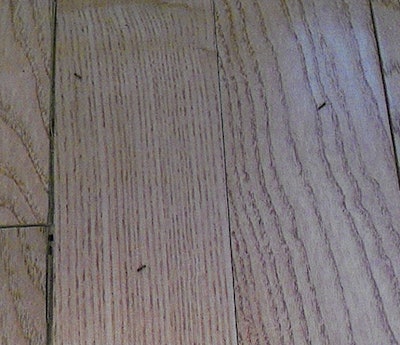
The Problem
I received an inspection request call from a retailer. A consumer with a solid 5/16-by-2¼-inch prefinished oak floor in her condo was complaining of shrinkage gaps and loose boards. Shrinkage gaps in solid wood flooring in Ohio in February are not an unusual complaint, but there was more: She said there were ants emerging from the gaps, and she blamed the wood flooring for the insects!
The Procedure
The single-level senior condo had wood flooring glued to the slab in the kitchen. According to the retailer, the floor was installed in August using the recommended adhesive.
The Cause
At the time of the inspection, the relative humidity (RH) was 25.1% at 70.7 degrees Fahrenheit. Moisture meter readings revealed a moisture content (MC) at the surface (¼-inch depth) ranging from 5.9 to 6.9%, with an average of 6.2%. Gaps between the long edges of the boards were visible. Most were less than 1/16 inch; there was one 1/8-inch gap in front of the refrigerator where the heat from the condenser blower hit the floor. The boards were solid and well-bonded, but showed some hollowness below the largest gap.
Small dark ants less than 1/8 inch long were visible on the floor. Some insects are associated with wet, damaged wood. Termites are common in the warmer Southern areas of the U.S., but usually not in Ohio. Carpenter ants also can be a problem. Both termites and carpenter ants live in and tunnel into wood.
Grease or thief ants are one of the smallest ants found in homes; they are yellow to dark brown and only 1/16 inch long. Indoors, these ants nest in cracks and crevices of walls and cabinets, under floors and behind baseboards. They prefer to eat grease, fats and meats, and can move in a column of ants between the food and the nest. Another small pest are "sugar" ants. Sugar and grease ants have no defensive sting or bite.
Carpenter ants are one of the largest members of the ant family (¼ to ½ inch). They prefer to excavate wood that has been damaged by water. Carpenter ants are usually black. They often set up satellite colonies inside homes from parent colonies located outside.
The Cure
Winter heating causing seasonal drying and gaps between boards is the most common wood flooring complaint in Ohio; humidification is the usual fix, so a humidifier was recommended to close the gaps. For the one spot with the hollow sounds, an epoxy glue gun was used to inject epoxy adhesive under the area.
In this case, since the ants were not carpenter ants, we could conclude that the wood flooring had nothing to do with the ant infestation, so a pest specialist was necessary. Ant nests are difficult to locate since the pests travel 30 feet or more in search of food. Ready-to-use insecticides applied into cracks and crevices in the vicinity of the nest may be effective, though re-appearance of the ants is common. Better success results with poison ant baits, but, of course, households with pets and children must take safety precautions with poison baits.
The Future
Be sure to always prepare customers for seasonal gaps if the flooring will be subjected to low humidity. Regarding ants, customers can be reassured that although carpenter ants can be a sign of wet and damaged wood, small ants are a nuisance not related to flooring or other wood.














